A tale of two statues
Beirut -- The images that everyone remembers of the fall of Baghdad in 2003 are those of the statue of Saddam Hussein being pulled down by American soldiers, two days after US forces entered Iraq’s capital in April.
The photos of that statue coming down, taken 15 years ago on April 9, 2003, are the ones that will forever mark that point in the country’s history. I shot the images from the balcony of my hotel. I was inside, sending what I thought was a much more interesting photo -- the desecration of another statue of Saddam, but by Iraqis, with no Americans in sight.
 Iraqis watch a statue of President Saddam Hussein falling in Baghdad's al-Fardous (Paradise) Square, April 9, 2003.
(AFP / Patrick Baz)
Iraqis watch a statue of President Saddam Hussein falling in Baghdad's al-Fardous (Paradise) Square, April 9, 2003.
(AFP / Patrick Baz)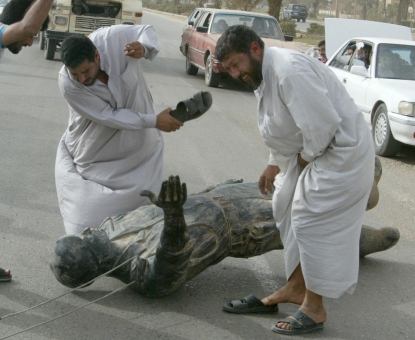 Iraqis hit a statue of Saddam Hussein with their sandals in Baghdad on April 9, 2003.
(AFP / Patrick Baz)
Iraqis hit a statue of Saddam Hussein with their sandals in Baghdad on April 9, 2003.
(AFP / Patrick Baz)
I came to Iraq on assignment for the first time in 1998. Back then, the ministry of information was in charge of issuing visas to journalists. The procedures were complicated and the visas hard to come by. I found a way around it. At the time, there was an Iraqi photographers’ association, based in Baghdad. One of its officials was the personal photographer of Uday Hussein, one of Saddam’s sons. A colleague put me in touch with him and he was able to get me a visa, bypassing the dreaded ministry of information.
In 2002, when the specter of a Western military operation against Iraq began to look more and more likely, I was sent to Baghdad to reinforce our bureau there and to prepare for any eventual invasion. The ministry of information refused to give me a visa, but I managed to get one through the photographers’ association again. I went in by car from Jordan. Back then, you had to take an AIDS test on the border in order to come into the country. I thought it wiser to pay a 25-dollar bribe rather than risk a test with a needle whose provenance and cleanliness was not at all certain.
In December, we set up shop at the Rashid Hotel in Baghdad Square. We rented out a suite that we then transformed into a mini bureau, replete with equipment, food, water. We had some unusual decisions to make back then. For example what to do with nuclear/biological/chemical weapon protection kits? Back then, the US was accusing Iraq of having an arsenal of weapons of mass destruction. Eventually those accusations would prove false, but at the time, we believed them. We couldn’t practice trying on the kits, because they became obsolete as soon as they were opened.
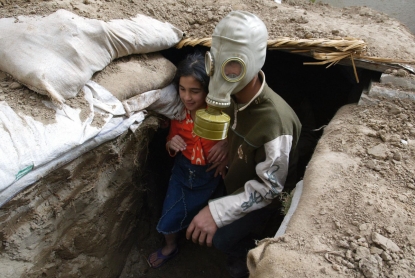 Iraqi Mustafa Mohammad, 13, wearing a WW II gas mask, plays with his sister Haya in a trench shored up by sandbags and bricks at their home garden in a Baghdad residential suburb, March 6, 2003.
(AFP / Patrick Baz)
Iraqi Mustafa Mohammad, 13, wearing a WW II gas mask, plays with his sister Haya in a trench shored up by sandbags and bricks at their home garden in a Baghdad residential suburb, March 6, 2003.
(AFP / Patrick Baz)That hotel made for some surreal scenes. One day a group of Chinese journalists arrived. They didn’t have chemical weapons kits like we did, but they did have cages of birds. They explained that, like the proverbial canary in a coal mine, the birds would alert them to any chemical attack. Baghdad markets emptied of birds soon afterward.
The invasion began on March 20. I took a photo of the first American strikes on Baghdad. Digital photography was just coming into use back then and I could tell right away that I had something.
 One of the first air strikes on Baghdad, March 20, 2003.
(AFP / Patrick Baz)
One of the first air strikes on Baghdad, March 20, 2003.
(AFP / Patrick Baz)The hardest thing to live through back then were the alarm sirens, which often would go off at the same time as the muezzin calls to prayer. You knew they were announcing that death was about to strike, but you didn’t know where. Every time they would go off, anti-aircraft batteries would release smoke into the skies of Baghdad.
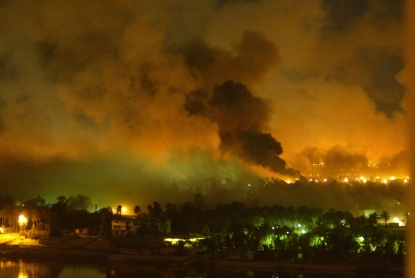 Smoke covers the presidential palace compound in Baghdad 21 March 2003 during a massive US-led air raid on the Iraqi capital. Smoke billowed from a number of targeted sites, including one of President Saddam Hussein's palaces, an AFP correspondent said. AFP PHOTO/Patrick BAZ / AFP PHOTO / PATRICK BAZ (AFP / Patrick Baz)
Smoke covers the presidential palace compound in Baghdad 21 March 2003 during a massive US-led air raid on the Iraqi capital. Smoke billowed from a number of targeted sites, including one of President Saddam Hussein's palaces, an AFP correspondent said. AFP PHOTO/Patrick BAZ / AFP PHOTO / PATRICK BAZ (AFP / Patrick Baz)Just before the invasion, we left the Rashid, following American colleagues who were advised to do so by US authorities. Everyone moved into the Palestine Hotel. We managed to get several rooms on the top floor, which allowed us to have a 360-degree view of the surrounding area.
After a few days, the war entered into its own rhythm, punctuated by sirens. We moved around freely in Baghdad, staying away from the “photo safaris” organized by the ministry of information. We had to have a government minder with us, a nice guy who would eventually tell me that among his obligations was to give a daily report at the end of the afternoon of what we did and said. He would supplement his reports with comments on our personalities and never expressed too favorable of an opinion of his charges.
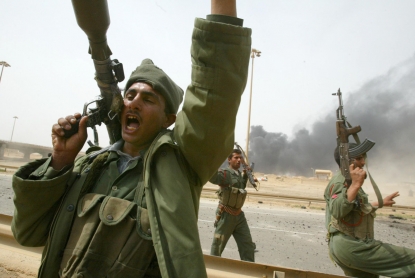 Iraqi Republican Guards shout anti-US slogans as they head to the front south of Baghdad on April 6, 2003. (AFP / Patrick Baz)
Iraqi Republican Guards shout anti-US slogans as they head to the front south of Baghdad on April 6, 2003. (AFP / Patrick Baz)It’s thanks to him that I learned that Baghdad had fallen, at 5 o’clock in the morning on April 7. He called me, saying “Go to the balcony, go to the balcony!” I went and saw clouds of smoke billowing from the presidential palace, members of the feared Republican Guard jumping into the Tigris and finally, the appearance of US tanks.
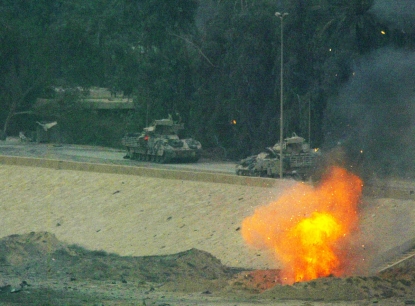 US amored vehicles clear Iraqi Republican Guard bunkers on the road around Baghdad's main presidential palace compound, April 7, 2003. (AFP / Patrick Baz)
US amored vehicles clear Iraqi Republican Guard bunkers on the road around Baghdad's main presidential palace compound, April 7, 2003. (AFP / Patrick Baz)The next day, April 8, we covered the taking of the city, violent and bloody. Three journalists would end up losing their lives, two of them because of US tank fire against our hotel.
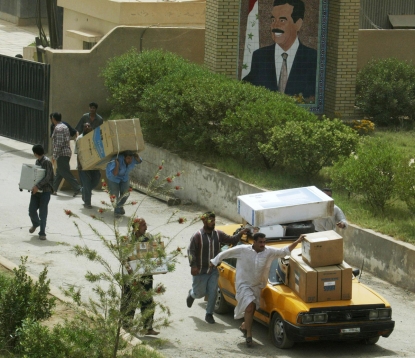 Looting at an oil ministry storage facility, April 9, 2003. (AFP / Ramzi Haidar)
Looting at an oil ministry storage facility, April 9, 2003. (AFP / Ramzi Haidar)April 9 heralded massive looting in the capital. We went out into the streets to see what was going on and in the neighborhood of Saddam City (later renamed Sadr City), I saw a curious spectacle.
One guy had attached a Saddam statue to the back of his car with a cable. He would stop whenever he would see a group of people, who would then gleefully hit the statue with the soles of their shoes -- one of the most insulting gestures in the Middle East.
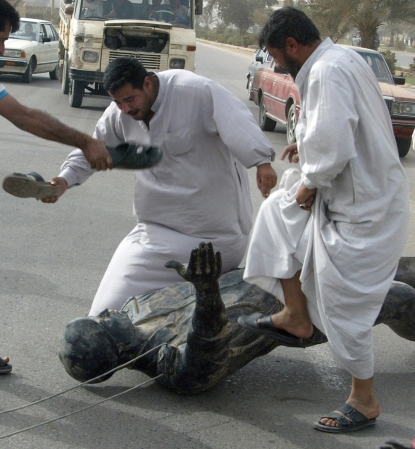 Iraqis hit a statue of Saddam Hussein, April 9, 2003.
(AFP / Patrick Baz)
Iraqis hit a statue of Saddam Hussein, April 9, 2003.
(AFP / Patrick Baz)The image was all the more strong because there wasn’t an American soldier in sight. Just the locals expressing what they felt about their country’s long-term dictator. I could hardly believe my luck -- I was the only photographer around (this was a time before smartphones and social media, when such an image would instantly be transmitted to the world by whoever happened upon the scene).
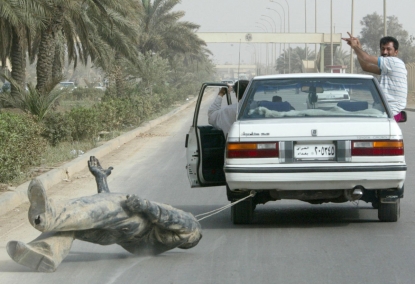 (AFP / Patrick Baz)
(AFP / Patrick Baz)Convinced that I had THE image, I hurried back to the hotel to send it to the desk. On the way, I ran into some American Marines who were completely lost. They were given maps with streets renamed in an American fashion, so that they could easily exchange with their colleagues, but were having a hard time trying to figure out where places like “Michigan Boulevard” were.
Once back at the hotel, I started sending my photo, very happy with myself for having scored such an image. I stepped out onto the balcony when I heard commotion outside.
I saw an US soldier first place an American flag over the face of a huge Saddam statue in the square. He then took it off, following orders from an officer. Other soldiers attached a cable around the statue, its other end attached to a tank. Eventually the tank pulled the statue down. Before it did, an Iraqi man kept hitting the statue as a small crowd watched. Later, people would say that the small size of the crowd showed that the move wasn’t a sign of popular will. But it took a lot of courage for civilians to go out in the streets like that, in the middle of a war. Or, as the old Arab proverb says, “When you’ve spent your life in a cage, freedom is a crime.”
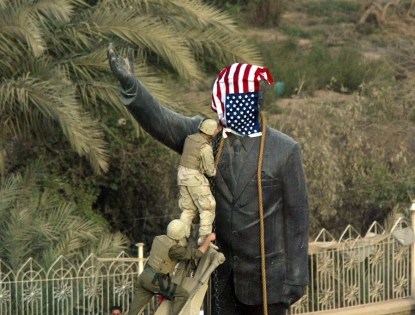 (AFP / Patrick Baz)
(AFP / Patrick Baz)That statue had to come down, to mark the day. My fixer was visibly moved. For him, as for a lot of people who had lived under the regime, it was Iraqi pride that fell along with the Saddam effigy. For me, what counted was the statue that Iraqis had themselves brought down, a bit earlier in the day.
This blog was written with Pierre Celerier in Paris.
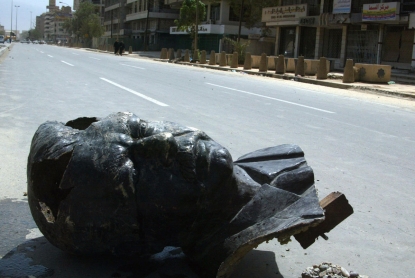 Baghdad street, April 10, 2003.
(AFP / Patrick Baz)
Baghdad street, April 10, 2003.
(AFP / Patrick Baz)


